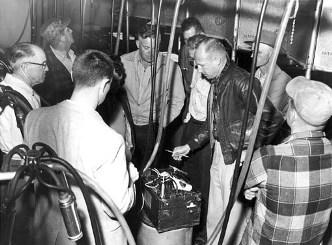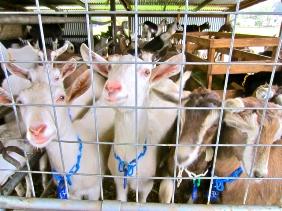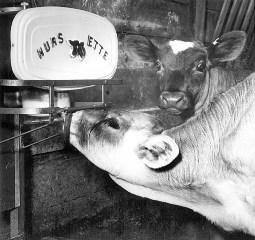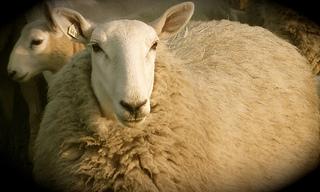
Milking machine school, 1959
Cooperative Extension plays an important role in Humboldt’s dairy and beef industries. When UCCE Humboldt began in 1913, there were approximately 850 dairy families and 28,000 dairy cows. The first UCCE Humboldt dairy program addressed dairy nutrition, and early dairy programs helped dairy farmers test their cattle, use records to maintain herd health, and handle disease-related cattle losses. After World War II, UCCE Humboldt dairy advisors held meetings and made farm calls to assist dairy farmers who were converting from milk production for manufacturing purposes to market milk production. Dairy advisors also supervised cow tester training and taught testers and dairy farmers how to understand and use computerized testing reports, which had replaced hand records. Importantly, dairy advisors also provided assistance to explain state law and government programs regarding milk production. By leading the way in milk pipeline technology, calf-raising programs, milk quality testing, and cheese manufacturing, UCCE Humboldt dairy programs have contributed to the success of Humboldt’s dairy industry, which in 1987 was Humboldt County’s largest generator (59%) of agricultural income. In 2007, Humboldt ranked in the top 6% of dairy-producing counties in the nation.

UCCE Humboldt has assisted local goat dairies. (Photo of goat dairy in McKinleyville by Kevin L. Hoover, Arcata Eye)
UCCE Humboldt continues to provide resources to dairy farmers. In 2007, UCCE Humboldt Farm and Community Development Advisor, Deborah Giraud, conducted a dairy goat economic study to analyze costs associated with operating a dairy goat business. In addition, Giraud facilitated the creation of the Humboldt/Del Norte Goat Milk Producers Association, obtained funding for dairy goat supplies, helped improve goat dairy practices, and started the first dairy goat auction at the county fair. In 2011, the UCCE Humboldt Livestock and Natural Resources Program provided significant input on the North Coast Regional Water Quality Control Board’s dairy permitting process. In addition, UCCE Humboldt is a partner in the California Dairy Quality Assurance Program, which was developed by Deanne Meyer, the UCCE Livestock Waste Specialist in Davis. This program was designed to educate dairy farmers about waste management and help them meet water quality control board requirements.

UCCE Humboldt also assists ranchers through their
livestock and pasture programs. Historically, many of the livestock programs focused on cattle nutrition, disease eradication, and forage and pasture management. Early farm advisors worked with ranchers, the Humboldt County Farm Bureau, and the Stockmen’s Association on beef projects, including eradication of tuberculosis and brucellosis, calf diet supplementation using meal and salt mixes, and promotion of semen and pregnancy testing. Extensive forage trials have also been conducted by UCCE Humboldt, including experiments on grass and clover varieties, irrigation, weed control and fertilization. In the 1940s, UCCE Humboldt worked with UC entomologists and successfully introduced the Klamath Weed Beetle to control the spread of Klamath Weed, which had infested 150,000 acres of rangelands. In 1987, UCCE Humboldt experimented with fly ash, the ash by-product of biomass wood energy production, which was demonstrated to be an excellent pasture fertilizer.

UCCE Humboldt offered sheep shearing classes in the 1990s and offered a wool handling course this past year. (Photo by Jill Hackett, Ferndale Farms)
In the 1980s and 1990s, UCCE Humboldt offered courses on ranch water quality to recognize the water quality issues that arise from raising livestock. The courses covered several topics, including sources of sediment in streams and rivers, and stressed monitoring streams and recording water quality improvements in annual ranch plans. In addition, these courses helped ranchers adopt sanitation practices by providing information on managing interactions between food crops and animals. Sheep-shearing schools were also initiated by UCCE Humboldt in the 1990s, and a new wool handling school is being offered this year. Today, UCCE Humboldt continues to assist ranchers through herd health seminars featuring talks by UCCE specialists and doctors of veterinary medicine and by providing information on pasture fertilization. UCCE Humboldt also continues to conduct research on and promote awareness of natural resources in rangelands, including wildlife habitat and weed management.




